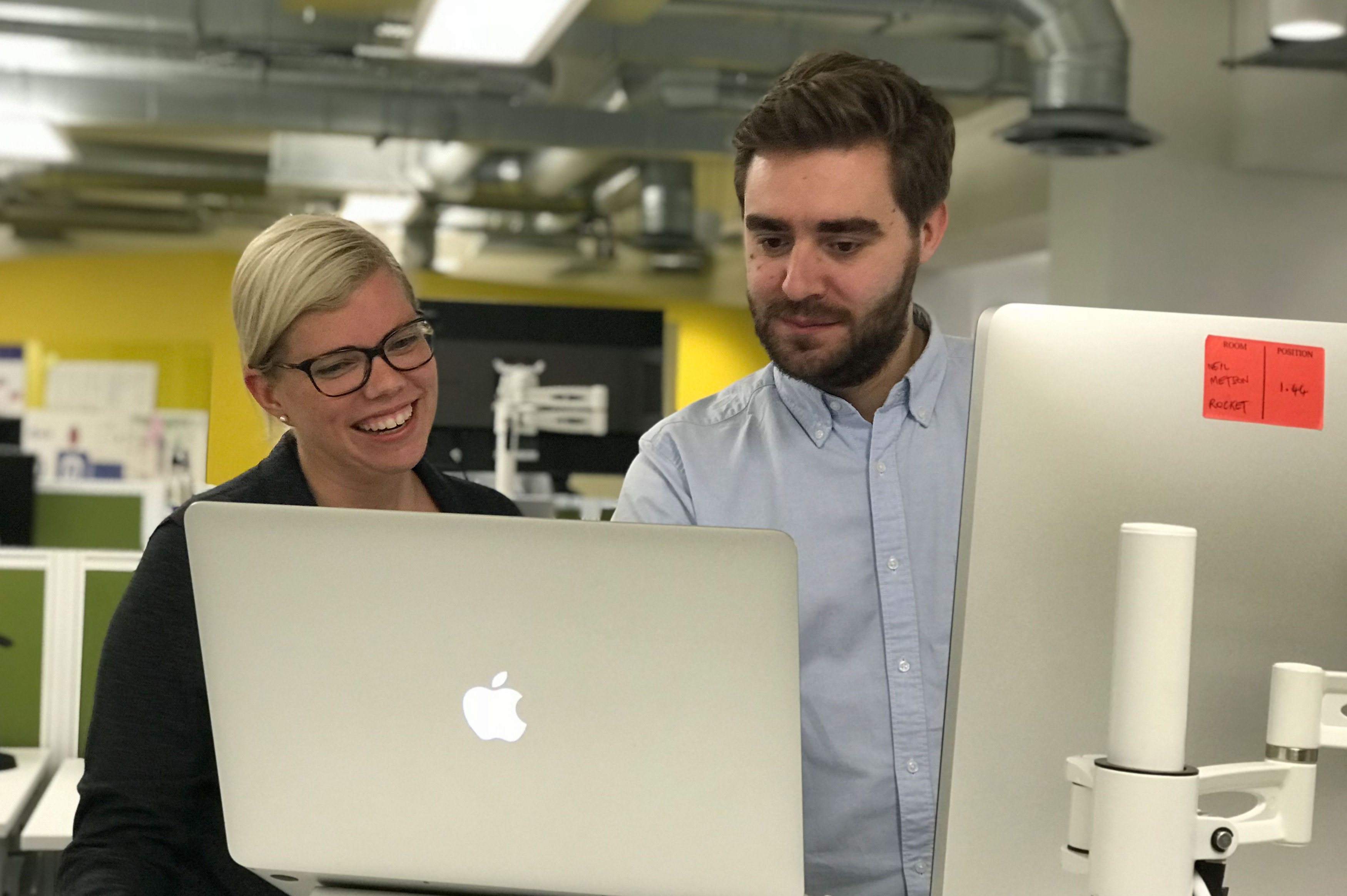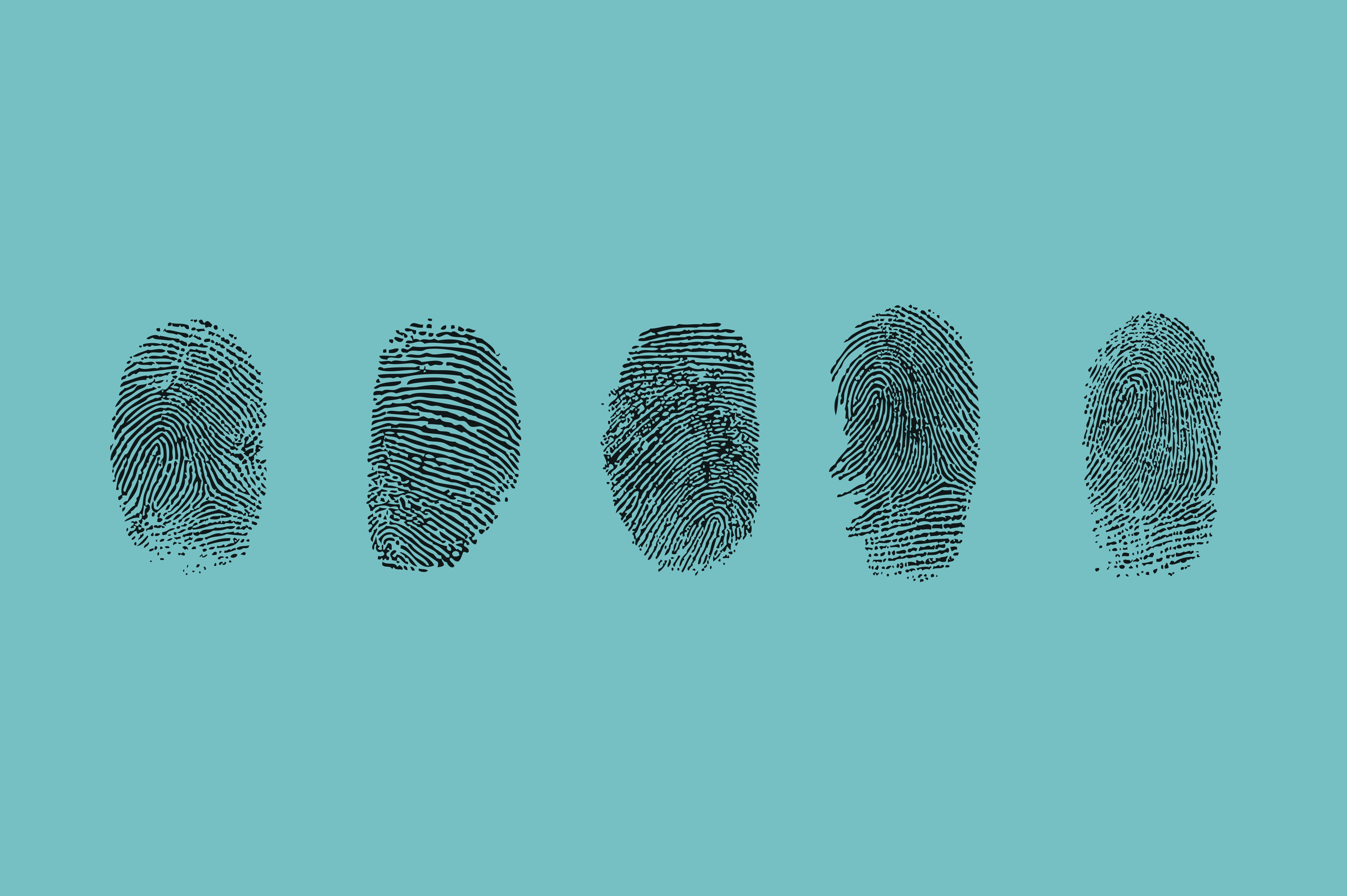Trends in tech

Trends in tech
Augmented reality has started to pick up speed with new tools and autonomous cars have gone from future technology to early adoption. This is a quick guide to some more tech trends.
Virtual furniture is only the beginning
The last ten years have evolved around the shift from big screens (desktops) to smaller screens (mobile). We are currently in the early stages of a journey beyond screens and into more immersive user experiences. Augmented reality (AR) is in the driver’s seat for this blurring of boundaries between the digital and physical world.
Simply stated, AR adds computer-generated images on top of the real world, either through a dedicated device (e.g. Google Glass) or a screen device such as your mobile phone. It has been around for years, but recently AR has started to pick up speed due to two key improvements. First, processing power and camera improvements are making mobile phones great AR tools. They also happen to be the easiest accessible digital layer to place between people and the real world. Second, recent advancements in artificial intelligence and image recognition capabilities have made machines much better at understanding their environment.
The most famous and widely adopted use cases of AR are Pokémon Go and the Snapchat filters that adapt to your face. These applications are quite simple and only have a basic understanding of their environment, but were still expensive and time-consuming to build. That changed this summer with the release of AR developer kits from Apple and Google. Think of these kits as a bag full of “Lego bricks” in different shapes and colors that allow you to start building great stuff in no time. More than 500 million iOS and Android devices can now use AR apps built with these tool kits.
Experiments flourish, with one of the most remarkable being “Ikea Place”. It allows customers to test how Ikea products would look in their home (size, color etc.) We know from experience that strong visuals drive buying engagement and this will no doubt be a game changer in online retail. It took Ikea only seven weeks to build the app using these new developer kits.
AR as an interface is in its infancy, and we can expect to see a lot more use cases emerge in the coming months and years. And, will we even need a phone in the future, when we could have a digital contact lens between ourselves and the world?
/Marius Olsen, VP Product Strategy Office.
Blockchain popularity is surging
At the start of 2016 the total market value of publically tradable (most of them are) blockchains was seven billion USD. In Q3 2017 that figure is fluctuating around 150 billion dollars – that is 20 percent of Apple’s total valuation. The space is seeing a surge in value as the technology is in a positive spiral with mainstream attention and because more and more people are experimenting (and speculating) on what “programmable money” could do. Blockchain is the technology behind Bitcoin, which can create trust between two unknown parties on the internet, without a central third party. This is an innovation with massive implications; blockchains will do to trust what the Internet did to information.
/Fredrik Haga, Investment Manager.
React while campaigns are running
Programmatic advertising is taking a big step forward, using data to understand user behavior. The Advertising strategic accounts team in Schibsted Spain is creating new attribution models that are taking this into account. Today digital campaigns are measured based on last post, clicks and impressions. But with more user data and new models, you can now define, identify and cluster much more specific user groups and reach them by programmatic buying. It also means that you can measure what perception and affinity users have towards a product or service, and their buying predisposition. This in turn, allows a much more efficient monitoring of behavior changes and reactions during the campaigns.
/Future Report
Clear road ahead for robot cars
Since last year’s Future Report, autonomous vehicles have gone from future technology to early adoption. Several real world tests are ongoing from the likes of Uber, Didi and Volvo.
Although the technology is increasingly likely to mature in time for general availability in 2021, challenges remain, such as regulation and insurance. New, behavioral issues are also being raised: Will self-driving cars clog roads instead of reducing traffic? That might be the case if cost conscious car owners let cars cruise the free roads instead of paying for parking. But, if there is a will there is a way, even for robo cars. Governments are starting to move, such as when the UK announced they aim “to be at the forefront”.
/Dan Ouchterlony, Investment Manager
Be prepared for the post privacy era

Be prepared for the post privacy era
The realization that the digital footprints we’re leaving behind are telling the story of our lives and our personalities has started to sink in.
But how does this really work, behind the scenes? Michal Kosinski, psychologist and data scientist at Stanford Graduate School of Business, knows this better than most. If you recognize his name, you might have heard it in connection with the Trump election. Kosinski’s research warned of the possibility of using data to influence voters in political campaigns. In the study conducted in 2013 Kosinski tried to see whether it’s possible to reveal people’s intimate traits just based on their seemingly non-informative footprints, like songs you listen to and your Facebook likes. And the answer is yes.
“Facebook probably knows more about you, than you do yourself”
“AI can be used to predict future behavior and help us understand humans a bit better. But one of the potentially negative implications is that it can be used to manipulate people, to convince them to do things that they otherwise wouldn’t have liked doing,” he explains. “Facebook probably knows more about you, than you do yourself. In the work that I published back in 2013 I said – look, this is possible.”
This is possible because a lot more than we actually publish on Facebook is recorded. Like your whereabouts, the messages you wrote but never sent, a friend that is stalking you, your spouse’s contacts, to mention some. “Maybe you never reported your political view on Facebook, but from your different actions and connections, Facebook will still know and tag your profile. Their reason is selling ads.” A lot of other industries have the same approach. Mastercard and Visa no longer define themselves as financial companies, but as customer insights companies.
“I’m a psychologist, I’m interested in human behavior and how we apply big data generated by humans to predict their future behavior and explain their psychological traits. But the very same models can be used to predict the stock market or the price of raw material or tech-hacking. There are consequences for media, for politics, for democratic systems, health care, you name it.” It’s AI:s that are putting the puzzle together. From all the digital traces we leave behind, they’re able to reveal patterns.
As humans we are only able to process a certain amount of information, and we don’t see all those links connecting characteristics and people. But the connections are there, and computers are excelling at putting them together, because they can tag patterns and they can aggregate those patterns. The very same predictions that can be made from digital footprints from Facebook, from language, websites and credit cards, for all those places where we interact digitally, can now also be made just on the base of your facial image.
“As humans we are predicting a broad range of traits from faces. From a fraction of a second of exposure, we can very accurately interpret an emotion. We have millions of years of training on this – because it’s so crucial for surviving. Being able to spot if someone is angry or very happy will determine if you should run away or hang around. We really don’t know how it works, basically your brain just does it.”
It turns out your face holds a lot of information. Gender of course, but there are also genetic factors such as the trace of your parents. Our hair reveals information on hormones, the tone of our skin, even environmental and cultural factors can be traced in our faces. And after just a few years of trying, computers are now great at predicting gender and age. And they have even become better than humans at the very human task of predicting people’s emotions. The problem is that we don’t really understand how this happens either.
“The mathematical foundation of the models is really simple; it’s basically a long equation, but with millions of coefficients, far too many for the human brain to comprehend. But the computers are able to spot those tiny details that humans fail to see, and add them up.”
In a recent study Kosinski also claims that AI now can detect sexual preferences, with a 91 percent accuracy. This has roared debate and been questioned, but still, there is no doubt AI already has abilities we could never imagine just a few years ago.
“When I’m talking about this in the western free market, people think of how some creepy marketing or politician will try to take advantage of us. But when you reflect on people living in countries that are not so free and open-minded, where homosexuality is punished by death, you realize that this is a very serious issue.”
Michal Kosinski is certain that we have entered the post privacy era, and there’s no turning back. And his message is that we need to think about how we want this to work out. “The sooner we start thinking about how to cope, the safer and more hospitable the post privacy era will be.”
20 years of online happiness
Infojobs is soon turning 20. Maturing in a Spain reeling from the financial crisis, the company morphed into something more than just digital job hunting.
1,205,731 – that was the number of job contracts signed using the Infojobs platform in Spain in 2016. We call this “alegrias” or “happy moments”, because we know that finding a job is much more than signing a contract. It’s a key moment in our lives, as it helps us care for our families, realize our dreams, grow as humans and feel that we are a part of society. Finding a job is also the excitement of preparing for an interview, the joy of getting a call that says you’ve been chosen and the pride when you have succeeded. It’s the peace of mind when knowing that when the moment comes, you’ll be able to take on a new professional challenge.
"We help society and it makes us proud"
This is what we’ve been doing at Infojobs for the last 20 years: helping people find a new professional challenge and experience these feelings. At Infojobs, we are here to help people to find the best jobs and help companies find the best talents. We help society and it makes us proud.
Our journey began in 1998, when Infojobs recognized the need for “dotcom” companies to find professionals within technology. This was anothera era, when the Internet was an unknown world for many people and job ads were published in printed papers. Infojobs brought the ads online and the success was immediate. Soon enough companies in other sectors and professionals saw the efficiency and followed. At this point, like most things online, the ads were free, in an area where companies were used to paying. It sometimes caused a bit of confusion, when costumers were wondering why they didn’t have to pay. For Infojobs it was also an era with some challenges, being at the forefront as a digital service, at a time when the number of homes and companies with internet was still very limited.
Happiness requires finances
But in the end Infojobs made the transition for job ads from paper to digital possible. In those early years we even worked with huge companies who came to Spain with multi-million euro budgets. We became leaders and had won the loyalty of our customers. These solid foundations made it possible for us to start charging for ads in 2000, putting a price on the value that we were adding to the market, as both we and the market were growing. And that’s crucial. To bring happiness, in the form of connecting people with jobs, requires solid financial health and one of the most exciting things was that customers who had been with us from the beginning joined us on this journey.
In 2009 the financial crisis hit Europe and Spain with devastating strength. At its worst more than 25 percent of the Spanish were unemployed, and a lot of people were having a difficult time as they couldn’t pay for their homes and bills or support their families. These were hard times for all of Spain. For Infojobs its very core idea was affected, as the number of job vacancies dropped sharply. But it also led to a deeper social engagement.
We started to ask ourselves how we could support some of all the people without a job even more. Since then we have kept supporting job seekers in different ways. Infojobs supports and participates in face-to-face events, offering free CV-workshops, interview coaching, tips on how to use the job platforms properly in order to find a job or how to take advantage of personal branding and social media when looking for a job. All of this is also available on our blog, Orientación Laboral, and we offer free online webinars. Infojobs is not only a place where you can find a job, it’s also a partner that gives you advice and information to improve your professional career.
Infojobs was born in the early web era and has now become a multi-channel platform. In November 2016, we reached the milestone of becoming Spain’s first employment app to have 1 million individual active users in a single month. This number is four times higher than any other employment services in the Spanish market, making us the leaders in the pocket-size world. But we haven’t stopped yet. With new players offering new services Infojobs has to constantly evolve to stay relevant. There is still opportunities for growth in the market, as more than 100,000 companies and over two million job-seekers are still not using Infojobs.
It’s AI or DIE
There’s also room for improvement. We can get even stronger by expanding our position along the recruiting chain, going down towards the transaction and not only limit ourselves to search and audience. And we will always keep listening to the companies that trust us and to the professionals who use us, locating their needs and trying new features and services. We also recognize the importance of tech and artificial intelligence in this – it’s AI or die.
This is where we are heading as Infojobs is getting closer to its 20th anniversary. Today seven out of ten online job opportunities can be found on Infojobs, 70,000 companies in Spain trust Infojobs every year to find talented employees. 60 percent of people looking for work online do so using Infojobs. And, what’s more, Infojobs works: one out of three people who apply find a new job. Beyond the numbers, the best and most satisfying proof of our success are the messages that we recieve from people who have found a new job and a new start in life. Or from the companies that have found the talents they need. These “alegrias” are the reason why we want to keep evolving.
Three ways of plugging the gender gap

Three ways of plugging the gender gap
During 2017, two events put gender diversity at the top of corporate agendas around the world. At Uber, a sexist culture was revealed and Google fired an employee who had published a controversial memo, criticizing the company’s equality policies. The fact that two of the world’s leading tech companies had to tackle these issues head-on shows the need to turn gender equality ‘talk’ into action across the industry.
To help make this happen, we have summarized three ways in which companies can take positive steps towards building a more gender-diverse workplace. But before we get to the solutions, let’s take a closer look at the problem. Roughly half of the world’s population is female, but you wouldn’t know it by looking at the technology sector. Recent public diversity reports reveal a 70/30 male/female split in leadership. It doesn’t end there; in Silicon Valley women only hold an 11 percent of executive positions, and trust us, it’s not because they aren’t built for the job.
The gender gap starts in school
In fact, the reasons for this are complex and many-fold. The gender gap in technology starts at an early age and carries on through every stage of women’s lives. When Youtube CEO Susan Wojcicki’s 10-year old daughter told her that “liking computers was super lame,” she was shocked – but, reflecting over the comment, admitted she shouldn’t have been surprised.
“Today this pattern is playing out with girls throughout America,” she said at a women-in-tech event. “They are led to think that tech is insular and antisocial. And they are never given a chance to correct those perceptions.”
“Liking computers was super lame”
On the other hand, double standards and unconscious bias towards gender are often so embedded in our culture – we often don’t recognize when we’re reinforcing them. To address this, companies have started to include diversity quotas into their HR policies. However, the solution doesn’t just lie in hiring our way out of a lack of gender diversity – it’s also about addressing low retention rates. According to a Reuters study 56 percent of women leave their jobs at the highlight of their career, which is twice the exit rate for men.
High returns on diversity
Despite these challenges, many companies are capitalizing on the direct benefits of fostering a diverse work environment. Consulting firms Catalyst and McKinsey each studied the financial performance of major organizations according to gender diversity at senior levels. Both reported that high returns on equity correlate with greater diversity. In essence, companies with women board directors and women in senior leadership are 15 percent more likely to outperform others. There are other obvious benefits of having women in tech at all levels – half of the tech users out there are women. Without a doubt, they have some needs that other women can detect and turn into business opportunities.
The good news is that there are things we can do at our workplaces today to help construct a sustainable ecosystem that will impulse gender equality practices in the long run. So, for those of you looking to push forward the diversity agenda in your own organizations, here is a list of industry best practices that can serve as inspiration:
Coaching and soft skill development
Recognizing the unconscious differences and bias between men and women in the workplace and providing training open to all to help create equality in the organization is essential. Focus on providing coaching and development for “non-technical” soft skills such as communication, networking, negotiation, emotional intelligence and confidence are important factors to ensure that women are able to progress in their careers.
Women Network and mentorship programs
Creating a network for women by women aimed at building networking opportunities, mentorship relationships and pushing general career development is a strategy that over 30 global companies have adopted to achieve higher diversity levels across all levels of their organization (see Google, Facebook, or Ebay).
Data-driven approach to diversity
What gets measured gets managed. Measuring and understanding diversity within your organization will help you draw a heat map of topics to address and needs to focus on. It’s wrong to assume that focusing on the current percentages is enough; the most powerful metric is retention over time.
One ID to rule them all

One ID to rule them all
What do 90 percent of all Swedes have in common? They use Bank-ID. In no time, a unified digital identification layer has become a daily savior. But sometimes trust comes at a high cost.
Large consumer banks have rightly been criticized for lackluster digital innovation and poor customer service. Fintech startups are running in circles around these dinosaurs and users are leaving in droves. Or are they? This is a story of one of the exceptions. This is a story of a revolution in accessibility and usability and huge risks. A story of how Sweden’s consumer bank oligopoly (Swedbank, SEB, Handelsbanken and Nordea) handed the keys to the kingdom to startup competitors, a story of radical empowerment, and a story of how a leapfrog in innovation could also turn out to be a technological dead-end on par with the French Minitel system.
Ladies and gentlemen, fasten your seat belts, this is the blockbuster story of Mobile Bank-ID. The story of WHAT?
As easy as touching your phone
Mobile Bank-ID. A secure digital identification, used by 90 percent of Swedes to open bank accounts, sign agreements, transfer money, take out loans and do tax returns. It’s as easy as holding your thumb to your Iphone. Gone are the scanned passport copies, logins, Pa$5w0rDs, confirmation emails, security questions and verification codes. No matter what the service. Even dating? Yep. The first thing many Swedes do when they buy a new phone? Yep, they log into their banks and install the mobile Bank-ID app on their phones. Most likely the service has wider national distribution than Facebook.
“What does it mean when an entire population is digitally identifiable?”
As a society we have adopted an immensely important and empowering technology, equal to GPS or credit cards. With little or no public debate as to the risks and issues. It just happened, with the consent and active support of the government. You see, we Swedes have no to little skepticism of centralization and we jumped like lemmings. We have put our digital IDs, our digital personas, squarely in the hands of banks and a small private company going by the name of “Finansiell ID-Teknik BID AB”.
Well, what do you expect in a country where every citizen is sampled for blood at birth, and where people (on average) like that fact that booze is only sold in state-run monopoly stores? As a matter of fact we love our Bank-IDs – 2.5 billion times yearly and growing rapidly to be precise. At the moment Bank-ID is used on average about once per day per Swede all year around. How did Sweden create a unified digital identification layer, and what does it mean when an entire population is digitally identifiable? It has enabled citizens digitally and made business easier, but how did we come to trust it so fast? Is it because practicality rules, or because Swedes blindly trust authorities and banks? Truth is, it’s really not that safe.
A logical evolution
Let’s start at the beginning. What is identification? Back when societies were small, and technology simpler than today, you knew if Sam was Sam by the looks of his face. Sam got into his bank vault just by showing up at the bank. The passport was invented in the 1400s by the British, but before World War I the use of identification documents was uncommon. As travel increased in the early 1900s the use of identification documents increased as well, among other things to combat espionage, and has been increasing ever since. Today, the banking system has been walled off by Government’s identification demands to stem money laundering. Banks are required by law to accurately identify each and every customer to understand where and why money enters the system. Normally, this identification is carried out by showing your ID card or passport. As banks have come to store most of our valuables in carefully protected digital bank accounts instead of physical bank vaults, accessing these with digital identification is a logical evolution. And so we started using passwords, PIN codes and other digital IDs.
Back in the present. In Sweden, as a market and an ecosystem we have solved a slew of challenges at once. Digital access to government services is solved. Digital signatures of documents is solved. Distribution of new fintech services is solved. PSD2 is solved. Instant payments is solved. From the eyes of fintech entrepreneurs this is heaven. Onboarding new users to a complex financial service is an astonishingly simple and powerful experience.
Surely this is socialist state Sweden forcing technology on its citizens. Or a zeitgeist-attuned entrepreneur inflicting technology on the people. Actually, the banks did it themselves. The incumbent, oligopoly-wielding, consumer banks of Sweden gave away the keys to their kingdom. In an astonishing feat of cooperation and consensus-building, a national digital ID standard was created.
Fuelled by dot-com optimism
The birth of Bank-ID came in the early 2000s, when EU amended the law to equate digital identification to physical identification. Fuelled by dot-com optimism, an unholy alliance of government and banks started driving the digital development of Sweden and in 2003 the first digital Bank-ID was issued. A few key governmental services were adapted and astonishingly enough that same year 27,000 tax returns were signed digitally. During the 2000’s Bank-ID existed mainly as a clunky desktop-PC experience until in early 2010 the first smartphone version was launched. Adoption and usage picked up somewhat towards the fall of 2012 when something spectacular happened: The large retail banks, again in a mind-boggling feat of cooperation, launched Swish, an instant mobile P2P payment solution. Small social payments were solved in the Swedish market. The Swish service required mobile Bank-ID and over the next 4.5 years as Sweden universally adopted mobile payments, we also adopted a secure, mobile digital identification as a consequence.
Carrying around a mobile Bank-ID in your pocket is not only extremely empowering, it is also quite risky. Going back to the brick-and-mortar bank vault metaphor, imagine you had it all in your pocket, the whole vault, all the time. Going to the pub with the entirety of your assets in your pocket sounds crazy. But that is exactly what most Swedes do, effectively. All accounts, all government data, all of it. People have been robbed of their Bank-IDs and even coerced to transfer assets, and it is a phenomenon that will likely increase. With great power comes great responsibility, and so far the Swedish banks and Bank-ID have moved decisively to repair trust. This will be critical for Bank-ID to age well, much like most people are kept unharmed by and even unaware of the ongoing credit card fraud.
Other types of more subtly fraudulent schemes are also challenging Bank-ID. One example is shrewd businessmen who are attracted by the power and simplicity of Bank-ID to lure users to sign up for bad products. Bad deals made easy. As users, our trust in Bank-ID is contagious so we implicitly trust in any service that uses the Bank-ID as it’s ID-layer. Saying yes and signing contracts with Bank-ID is deceivingly simple, and who reads the 20-page terms and conditions anyway?
Another example of swindling is the leakage of very sensitive data to third parties. There is a raft of apps offering consumers “help” to manage their assets or monitor their spending and budget. With a simple Bank-ID login, the entirety of your bank account transaction history can be transferred to the app. These are data that show some of the most intimate details of where, when and who you transact with. Not only which shops and products you like, but also inferred data from a too large cash withdrawal at midnight, or a certain pattern of fast food spending. We have yet to have had a public data breach of this kind, but it will most certainly come. Likely in the form of profiles being sold on the dark web, bought and then published for maximum negative publicity. And huge public outrage.
Is it possible that Bank-ID empowered the people just a little bit too much? Yes, sort of. But likely there is no way back. If the phenomenon of Bank-ID was a person, it would be an innocent seven-year-old, yet to be made aware of the dangers of the world. As it matures we need to brace ourselves for the many tumultuous years of teenage revolt to come.
Money is being reinvented
A more long term threat is the risk of complacency. If we take a short detour from ID into a related, but separate, part of the technology landscape, we can see that digital money is being reinvented by Blockchain and Bitcoin. Using some mind-bogglingly complex mathematics, the key innovation is that trust and ownership is established by total decentralization instead of total centralization. Most of today’s money is based on our trust in banks keeping our data secure in central storage. The same goes for Bank-ID: trust is established by the banks and Finansiell ID-Teknik BID AB keeping our ID data secret and secure.
But if money is decentralizing, shouldn’t identity follow? Many entrepreneurs certainly believe it should. Ashish Gadnis, founder of BanQu, is building a mashup of Blockchain and identity to make “identification borderless and immutable”. Monique Morrow, former Cisco Services CTO and evangelist, has founded The Humanized Internet with a similar goal.
Investors believe too. In Sweden a few high profile startups are trying to make the concept global: “Using our technology one can remove all usernames and passwords and use our app instead,” says investor and Covr Security chairman Anette Nordvall. Covr was founded by former employees from Bank-ID.
In June 2017 the high-profile startup Civic managed to raise USD 33 million in 30 seconds for it’s initial coin offering (ICO). Civic is building a distributed identity using Blockchain and biometrics on smartphones, and when asked if they will become a Unicorn soon, their high-profile CEO Vinny Lingham retorted on Twitter: “We’ll likely become a non-profit foundation before then. We aren’t building a company. We’re creating a new type of public utility!”
Given our runaway success, Sweden will probably be Bank-ID:ing away happily, ignoring the megatrend towards a decentralized, self-sovereign, ID layer. Meanwhile, communities and nations without a Bank-ID-type solution will leapfrog onto the solutions powered by Blockchain. Bank-ID is only a local maximum on the ever-rising ladder of innovation. And early success can be fatal in the long run.
How to make friends with robots

How to make friends with robots
Imagine. It’s 2025, and you’re slowly waking up. The robot next to your bed is beaming artificial sunlight in sync with the natural sunlight outside your curtains. It’s projecting today’s most important headlines on the ceiling above your bed and as your eyes flick through the news, you hear the shower turning on, coffee dripping and the stove working its magic.
A perfectly suited outfit is laid out on your bed. Your robot hands you your coffee and breakfast tailored to your flavor. A driverless car swings up, ready to take you to work. But perhaps you skip the ride, and rather put your VR headset on and lean back as a 3D digital office unfolds in front of your eyes. If you’re a sci-fi geek, none of these scenarios will seem particularly far-out. But how likely are we to experience a future in which these scenarios no longer belong to fiction, but are as a natural part of our day as smartphones? And is this a future we want?
“What kind of future do we want?”
Japan has always been a frontrunner in technology. Erica, a semi-autonomous android, resembles a human; modeling a plastic skull and silicone skin with wires connecting her to AI software systems that bring her to life. She is the result of one of the most funded scientific projects in Japan, and a collaboration between Osaka and Kyoto universities and the Advanced Telecommunications Research Institute International. Her creators, Hiroshi Ishiguro and Dylan Glas, claim Erica is “living” proof that the future might be closer than we think. Using sensors and microphones, she is able to pick up what people are saying to her, and through AI software, she can respond convincingly. Erica works as a receptionist at their laboratory.
It makes sense to emulate humans
The tech-industry knows that humans are inherently wired to recognize and interact with other humans. So from a behavioral adoption point of view, it makes sense to develop robots emulating the human body. They do rely on our adaptation – fueling their machine learning minds in order to make them smarter – or more human. And the only way to achieve this would be to stimulate frequent, continuous and human-like interaction over time. Research also shows that we tend to find robots endearing as long as they resemble something non-human, like animals. The moment we encounter robots that resemble humans we find them troubling.
That said, we are capable of developing feelings for robots. Multiple studies have been conducted, in which the results clearly imply that we subconsciously start treating machines around us like social beings – given the right context. Several studies have shown participants feeling grief and remorse when either requested to abuse or witness a robot being abused. In one study observers could watch how participants found it nearly impossible to push a button that indirectly would destruct a friendly-looking robot if it misbehaved, while it begged to be forgiven. Technology has consistently functioned as a catalyst to a more efficient, healthy and sustainable world. For example, in the healthcare sector we’re seeing huge advances with life-saving techniques leveraging AI to aid doctors with disease diagnosis.
It ‘s up to us
Robots, created in both hardware and software, will inevitably shape our future. How we let them do that, is up to us. Robots of the kind depicted by Erica will not be ubiquitous in the next few years. To give you a picture of the magnitude of complexity required to design the interplay between the software and hardware that keeps a bot on its feet, it typically takes more than 500,000 lines of code to put one foot in front of the other. Then again, this is an ability that took hundreds and thousands of years of human evolution for humans to perfect.
Perhaps our concerns with humanoid robots will never materialize. Considering the pace at which humans are integrating closer with technology, through enhancements of the sorts like BCI (Brain Computer Interfaces), exoskeletons and eventually nanobots streaming through our body, maybe the question should not be whether robots should resemble humans. Perhaps the integration of human and technology will redefine what it means to be human. Together as consumers we have more power than robotic scientists. Technology has to adapt to us, because we can’t adapt to it fast enough. At this point in time, we should be asking ourselves what kind of future we want. And the most important question remains to be answered: Which ethical standards, values and goals do we choose to pass on to our mechanical companions?
Stop typing, start talking

Stop typing, start talking
Machine learning and AI are fundamentally changing the way we interact with our computers. Perhaps the best interface will be no interface. Let’s just talk.
“It’s part of the human condition to think that if we struggle to use something, we assume that the problem resides with us,” said Jonathan Ive, Apple’s chief design officer. The best type of user interfaces are the simplest ones, the ones that work intuitively and doesn’t require much analysis on our parts, but adapt to our ever-changing needs. This insight uncovers a hidden reality of using computers: we have to adapt to their behavior. We learn their foibles, they don’t learn ours. But perhaps we’re getting closer to the ideal user experience – no interface at all. Chatbots and voice are still at their very beginning. But everything points towards that we will be talking a lot more in the future.
“We are going from talking through messaging apps to chatting to machines”
Computing paradigms change every 10 to 15 years; they’re typically defined by how they operate with the outside world – meaning we have to change with them. The first computers purely operated via command-line (or text) input. They required linguistic skills of a precision that the Academie Française would have been proud of. The graphical interface (GUI), pioneered by the Xerox Alto, popularized by the Mac and dominated by Microsoft Windows, took hold in the late 1980s. GUIs were more forgiving visualizing everyday metaphors like files and folders on a color screen. This is the computing most of us know. Multi-touch computing, pioneered by the Apple Iphone, was a third revolution, point and draw with your finger, what could be simpler? The Iphone fundamentally changed the way we interacted with technology, our expectations, because the whole screen became a playing field.
Chat is natural
Smartphones, in turn, paved the way for the rise of messaging apps. We now have countless ways of contacting each other, whether it’s on Imessage, Whatsapp, Messenger, Slack, Skype or Wechat. And since it makes sense for companies to try to talk to us, using the same channels we use to talk to one another – chat and chatbots have received a lot of hype – becoming, you might say, our latest interface. The reasons are clear: chat is natural and we spend a lot of time in chat applications. Turns out chatbots are also ludicrously easy to build. But it also turns out, building a great chatbot is a lot tougher than building a chatbot. If you’ve ever tried chatting with a chatbot you’ll know why; the conversation is dull and repetitive. God forbid you ask an original question only to be met with utter incomprehension.
So, we’re still pretty far from the ultimate interface, but no doubt, things are happening. Today, the technology is converging and leaps made in one field serve another. Natural language processing (NLP) enables chatbots, image recognition enables self-driving cars, voice recognition enables Alexa, Google Home, Siri. Those are all different branches of machine learning and we’re getting better and smarter at it, at an increasingly faster rate. A few companies are now starting to reach that level but we’re still in the early days. Yet, according to experts, by 2020, 85 percent of all customer interactions won’t require human customer service reps; indeed, those interactions will happen over chat, but also over voice.
We are going from talking to one another through messaging apps to chatting to machines. What’s the next step? Eliminate typing, and use your voice. Going back to the point on the importance of keeping user interfaces simple, voice is a big deal. To quote the eponymous book, the best UI is no UI. No design is required if you could simply talk to your device.
Today, voice AI such as Siri or Alexa, are limited by two things: technology and architecture. On the technology front, speech recognition and text recognition still have a lot of room for improvement, especially if your English is somewhat accented. (Fun experiment, ask Siri to “Google Tchaikovsky” for you with a French accent, you’ll get surprising results.) Their architecture is based on general themes, the AI is able to draw context from the user’s request, classify it and answer it accordingly. What it has a hard time doing however, is to follow a conversation, remember pieces of information mentioned three questions back and use it when needed. There’s no dropping birthday gifts hints with Alexa. But thanks to the millions of users that interact with it regularly, the AI is getting plenty of training and gradually getting better.
A voice AI good enough for us to freely chat with would be extremely liberating: no more staring at your screen constantly, just chat with your AI, how cool does that sound? Nevertheless, voice AI raises some really challenging UX problems. How do you teach your users to use an interface which is actually invisible? What will be the standard keywords to which Voice AI will respond to and who will set them?
We know the world is changing
Can Voice ever be good enough to be totally unscripted, feel as seamless as talking to a fellow human? The answer to this question is more a matter of belief, than it is hard science. We cannot anticipate the changes that will happen with the exponential development in tech and what we will be able to do. For now, a “Her”-like society is definitely science fiction.
What is very real, however, is the short-term impact voice and chatbots will have on the way businesses interact with their customers. Indeed, 32 percent of executives say voice is the most widely used AI technology in their business. Six billion connected devices will proactively ask for support by 2018. By the end of 2018, customer digital assistants will recognize customers by face and voice across channels and partners. HSBC has already implemented voice recognition as a secure access to one’s banking details.
We all know that the world is changing and it’s changing faster than ever. Not that long ago we were all going nuts about tactile screens – “it works without buttons!” – and now we live in a time in which soon all homes in developed countries will be equipped with voice AI devices to facilitate and organize our lives. And where businesses will interact with their customers in a way that is barely invented yet.
AI will power our life

AI will power our life
There’s a bigger picture beyond the progress of Artificial Intelligence. Just like when electricity arrived we can’t yet see the full effect. And just like with electricity – life without AI will be inconvenient and unpleasant.
In October 1881 in the small British town of Godalming, the world’s first public electricity supply went on stream, lighting a few dozens incandescent lamps in the town’s streets. The small local firm, Calder and Barrett, had, with their small hydroelectric generator, passed a milestone in the electricity revolution. From these humble beginnings, electricity rapidly became part of the fabric of our lives. The American inventor, Thomas Alva Edison, opened his first public generator in London some three months later, followed by a New York generator some nine months after that.
“Entire industries will benefit from the arrival of the AI, as they did with electricity”
In the US the process of electrifying the nation was mostly complete within 50 years. Today electricity is a utility, not even a commodity. It just works. You can’t really imagine life without it. It is the same everywhere in the world. Everything we do, we buy, is based on the assumption that we’ll have access to electricity. And today, more than 5.5 billion of us do. So when Andrew Ng, one of the most influential forces in today’s artificial intelligence boom, describes AI as the new electricity we stop and take notice. After all, electricity changed industries, jobs, our everyday lives and our social and domestic relationships. Could we perhaps glimpse the second-order effects of artificial intelligence by understanding how electricity shocked the world?
The first experiments with electricity showed the technology could work, lighting bulbs in daylight is a scientist’s a-ha moment. But it wasn’t a study of electricity itself that wrought changes, it was the application of electricity that did. What is interesting is using electricity to power lights to extend the practical day. Or using electricity to reduce the hardship of domestic chores. Or using it to power new classes of production processes – like The Haber-Bosch process for fixing atmospheric nitrogen and creating artificial fertiliser is heavily dependent on electrical energy. Many of today’s AI a-ha moments are a scientist’s Eureka: being able to transcribe speech to written text or describe what is in an image at higher than human quality. But, like with electricity it is the applications, not the technology, that will be the impact of AI in our lives.
Life will seem inconvinient
AI will be deployed rapidly, made available to every part of the industry and home very quickly. In the UK, by 1933 one in three houses had electricity and a further ten years down the road two out of three houses were electrified. The spread of electricity was accompanied by a rapid increase in the intensity of use. The amount of electricity used per consumer grew from about 2 MwHs per household per annum in the 1930s to close to 11 MwHs per household by 2014. This was accompanied by a dramatic drop in the price, almost four-fold in real terms over that same period, and a drop of about 20 times from the turn of the 20th century to the turn of the 21st. AI will be deployed far more rapidly than the appliances that used electricity – because the components it needs to work are already in place. Smartphones in our pockets, wireless internet, digital cameras, cloud-based services. Artificial intelligence will be ubiquitous, wherever there is the internet (and in many places where there isn’t.)
AI services will become indispensable. Life will seem inconvenient, even unpleasant, without it. When I was a child, I would visit my grandparents’ home in Lahore, a house they had lived in since the partition of India in 1947. This old house didn’t have a flush toilet. A minor thing, humanity had lived without flushing loos most of its time on earth, but an inconvenience to make a Westernised grandson ill-humoured. Our expectations for interactions to be AI-powered will rise rapidly. We’ll expect our clinicians to spend time explaining our diagnoses to us, not diagnosing us, because AI systems will have more effectively identified our ailments than any human. We’ll tire of waiting in traffic queues with aching backs because our autonomous vehicles will find the best route for our journey.
New industries will rise
Entire industries will benefit from the arrival of the AI as they did with electricity. In truth the electrical companies did well, but not as well as the fossil fuel companies who provided much of the raw input. Nor as well as the cambrian explosion of firms who could exploit new business models because of the arrival of electricity. Shopping malls make no sense without electricity. Television makes no sense without electricity. Even frequent air travel is not possible without electricity.
AI will drive an analogous Schumpeterian process: industries arising, replacing others. Take the car industry: it has a century-old model of selling us cars through distributors who make money through service and repair. The car industry itself supports the advertising and media industry who are enlisted in manufacturing desire around this mode of transport.
Yet the car industry looks like it will be upended by new modes of on-demand transport rental: autonomous vehicles routed to us by algorithms. Much like electricity, the biggest impacts of AI will be felt outside its home industry. AI will also transform work and with that a transformation of our social relationships. Rural electrification in America, which occurred in the years before the depression, was driven by women. Unlike men, who worked seasonally, women worked from dawn till dusk throughout the year. Electricity, with its washing machine and kitchen stove, alleviated the burdens of their work and, with its radio, connected them to wider society.
How will AI transform our labor structures and with that our wider society? Electricity provided power where it was needed, automating manual tasks, for example washing clothes. It also provided lighting, extending the working day and creating time for in-home leisure. Radio and then television appeared to fill the gap. Artificial intelligence will free up time by taking up some of our cognitive load. It could create free time for us, the same way cheap lighting enabled by electrification extending the day, for both work and leisure. There are any number of taxing but low-value tasks that you could foresee leaving to machines. What we do with all that time, remains to be seen. No wonder that as I talk to business leaders in industries like retail, health diagnostics, professional services and finance, their number one priority is artificial intelligence.
An engaged public debate
Of course, electricity brought with it fears of this ‘mysterious fluid’. American President, Benjamin Harrison had the White House wired for electricity but refused to touch the switches for fears of shocks. It probably didn’t help that it was during Harrison’s term, the first man was executed in the electric chair. William Kemmler died in August 1890, before Edison’s Pearl St generator opened. His execution was botched and resulted in a gruesome 8-minute ordeal. Like electricity, artificial intelligence is bringing forward many fears. Will AI amplify the biases in the world? Will AI lead to persistent and chronic unemployment? Will AI create new megalithic dominant firms controlling large parts of the economy?
These are all real concerns. AI systems have already been demonstrated to systematically bias the bail assessments of black prisoners in the US. And academics, Daron Acemoglu and Pascal Restrepo, have demonstrated that the use of robots in industry depresses both wages and employment levels. And one only need to look at the dominance of Amazon in retail, and Google and Facebook in advertising, to see the risks of market dominance driven by data monopolies. The only way to manage these fears is to have an engaged public debate on the many ways AI will impact the economy, something that is happening in many countries today. For example, in the UK both houses of Parliament have public consultations on the impact of AI underway.
When we think about AI today, we need to go back perhaps not to Edison’s pumping station on 1892. Perhaps AI today is more like electricity in the 1920s America, spreading fast but in limited intensity. But around that spark of intelligence, entrepreneurs and incumbents are figuring out how to apply this soon to be ubiquitous technology in our everyday lives. I believe AI services will generally have one of four major benefits: Relate, not diagnose – AI does diagnosis saving time for human communication; Maintain, not repair – advanced diagnostic systems spot likely failures well ahead of time allowing proactive maintenance; Connect, not collect – machine learning systems end up personalizing specific needs and requirements rather than broad buckets; Take out the boredom – machine learning systems do the boring work, leaving humans to do the interesting, challenging parts.
Four benefits from AI
Relate, not diagnose: Online test-prep company Magoosh uses AI software for customer service, allowing the human providers to respond to more test-takers more quickly: the software has reduced Magoosh’s queue of customer requests by half, and it has made her team’s goal of responding to every customer within 24 hours more manageable. Dr Rajesh Jena, a consultant neuro-oncologist at the University of Cambridge Cancer Centre, has worked with Microsoft researchers to develop a tool which provides accurate 3D visualizations of tumors and organs. This has cut down the time it takes to identify a neuroblastoma from a few hours to four minutes, allowing the specialist more time to counsel the patient.
Maintain, not repair: As our devices get smarter and connect to the net, the so-called internet of things, we’ll be able to proactively maintain equipment rather than repair it when it breaks. One favorite area is to detect faults in offshore wind-turbines weeks before they become critical. This saves money, as prevention is better than cure. It isn’t just wind turbines were prevention is better than cure. The same goes for humans. Cardiogram, an AI-enabled app on Apple Watch, detects irregular heartbeat with 97 percent accuracy, while NVIDIA’s efforts to combine 3D modeling with AI could spare 60 percent of patients from getting angiogram, an invasive and costly scan.
Connect, not collect: One of the leading insurance and investment companies in the U.S., Transamerica, employs machine learning to make product recommendations to its potential customers. McGraw-Hill Education presented its web-based artificial intelligent assessment and learning tool last year, using graph theory to test the process and speed of learning for each student. Machine learning algorithms can follow students’ learning patterns and create personalized learning pathways for individual learners.
Take out the boredom: Automated systems already take the tedium out of flying a plane. Pilots are left to handle the take offs and landings. Autonomous trucks, buses and cars could take out the tedium of driving for long stretches, leaving humans to manage passengers – or even relax. AI systems in legal document discovery spare junior lawyers hundreds of hours of combing for juicy morsels. Those lawyers can be put to more valuable tasks.
About Schibsted

About Schibsted
Schibsted Media Group is an international media group with some 7 000 employees in more than 20 countries. From Scandinavia to Brazil – millions of people around the world interact with Schibsted’s popular digital services every day.
In Scandinavia, our media houses such as VG, Aftenposten, Bergens Tidende, Aftonbladet and Svenska Dagbladet keep people informed and updated on important issues in society. Our digital marketplaces such as Finn.no, Blocket.se and Leboncoin.fr help people buy and sell new and old things. Our growth companies such as Shpock, Let’s Deal and Compricer provide our users with popular, digital consumer services that make their everyday life a bit easier. Together, this fulfills Schibsted Media Group’s mission of “Empowering people in their daily life”.
Providing consumers with high quality and user friendly products and knowledge makes Schibsted a driving force in the digital transformation of society, thereby empowering people to influence, learn and interact and to be a part of a new world of opportunities. At Schibsted we are visionaries, journalists and entrepreneurs, builders and idea creators. But everyone share a dream of change: we hope to make the world a little bit better and life a little bit easier for our users.
Postboks 490 Sentrum
NO-0105 Oslo
+47 23 10 66 00
Learn more at www.schibsted.com
Read about Schibsted and social responsibility http://howwecare.schibsted.com/how-we-care/
Meet our people

Meet our people
Schibsted has more than 7000 employees all over the world, working in different areas and exploring new fields. Meeting some of them, will give you a closer idea of what Schibsted is all about.
“My colleagues help me learn and grow”
When she arrived in early 2016 she started from scratch, building a team working with natural languages processing (NLP) and image recognition. Now they’re part of realizing Schibsted as a tech-based company.
”It’s been a great experience doing this from start, and I get to work with exceptionally talented colleagues, who gives me the opportunity to learn and grow,” says Atelach Alemu Argaw.
The team builds state-of-the-art models and services, using data from users, and makes them available within Schibsted. “These reusable models, components and services can easily be plugged into various applications and relatively easily extended to new use cases and data.”
NLP is an AI-based technology aiming to get computers to understand how humans speak, or write. Atelach’s team has built a model for labeling the intent of a message. This means that you can understand when buyers at a marketplace are interested in an item that already has been sold, and assist the seller in answering them. When it comes to image processing the team has, for instance, made it possible to show similar items to buyers (turn the page to find out how it works).
“The really exciting thing will begin when we build models that combine text, images, meta data and user behavior. Then we will be able to improve the user experience, for example by making it easier to upload ads at our marketplaces.”

Years in Schibsted: Almost two. I’m excited about: Using our data and machine learning to enable our products which in turn empower our users.
Clicks turn into real user profiles
Delivering a good advertising experience, for both users and advertisers, is a tricky business. Tim van Kasteren and his team are building predictive data models, to help advertisers target the right audience.
“Let’s say we know the gender of a couple of thousand users. The predictive model uses machine learning to learn the correlation between the behavior on our sites and the gender of the user. We can then use that model to predict the gender for all of our users.”
At the moment the models are able to predict gender, age, location, interest and intent to look for a job.
“It’s really satisfying to see how individual clicks on our website end up being a complete user profile that helps us to connect advertisers and users in a relevant way.”

Years in Schibsted: 3. I’m excited about: Getting the entire organization involved in using data about our users.
Young people want the device to do all the work
A simplified and quicker service, adapted to the modern user. This is what Kufar will become with the new Schibsted marketplace platform.
“Young people want the product and devices to do all the work,” says Tanya Lemesheva, product owner at the Belarus site. Bit by bit Kufar is transferring users to a new product, based on the new platform, and as they go along they give feedback to the developing team.
“Ad insertion will be easier, quicker and more intuitive. For instance you don’t need to choose category – it’s automatic, based on the photo. We will also use machine learning to detect users’ preferences, which means that we can give really good recommendations.”

Years in Schibsted: 4. I’m excited about: Virtual reality and its potential.
“It’s great to build a new business”
In December 2016, Italy got a new service for comparing prices – Pagomeno. Tiziano Barbagallo is the new Country Manager, and he has reasons to be happy. We reached more than 500,000 visits when we launched and traffic is growing constantly each month.”
Word of mouth has been a big help to get consumers to know the new brand, Tiziano and his team get proof of this every day, following users’ comments in forums and blogs. Being a new player in Italy, there’s still things to work on, like defining a mobile and native app strategy and building a motivated team.
“It’s great to work with a new business from scratch and touch all the aspects of a company, like strategy, sales, marketing and customer support. And to be able to help people buy the right products and save money.”

Years in Schibsted: 4. I’m excited about: The opportunity to make a change in Italy’s competitive arena of price comparison industry.
”It’s like everyone owns the brand”
Avito has become a role model in Morocco. The marketplace is an inspiration to push market economy and for its culture, and not least, for reaching 6 million users each month in a country where people didn’t really sell old things. Zakaria Ghassouli became General Manager in July 2017, but he joined the company in 2012.
”Even though I’ve been here for quite some time, I started out as GM talking to everyone. I wanted to learn about their motivations and frustrations.” This is what the Avito culture is all about – openness and transparency, which has created engagement and involvement.
”It’s like everyone owns the brand.”
When he started, Zakaria got a classic question from his mother: ”When will you get a real job?” Marketplaces weren’t a known phenomenon and Moroccans were in the habit of keeping their stuff. Luckily they also like making good deals.
Avito is also driving change in a wider perspective.
”Large companies visit us to learn how to build a strong culture, be more agile and market-orientated.” At the moment Avito is implementing the new Schibsted marketplace platform, which will help them grow and control more of the value chain to reinforce their leading position.
”But just as important is to keep developing our offers. Right now we’re looking at vertical opportunities such as real estate and jobs.”

Years in Schibsted: 5. I’m excited about: Leading more than 100 inspiring colleagues in revolutionizing the digital ecosystem and help companies and individuals do business.
Blogging for advertisers
A blog with content for advertisers has been a great tool for Tori to build their B2B brand among Finnish advertisers and other target groups.
”Our brand is strong among users but we’re not that well known by advertisers, so we are working with content marketing to get in contact with them”, explains Laura Kuusela”. For instance Laura and her team made a handbook for digital marketing that has been very appreciated and that has worked as a tool for this B2B marketing.
“The most important thing is to know who you are doing it for, to follow your target group and then produce what is interesting to them.”
And it works. Advertisers like to discuss what they’ve been reading. “That’s a really good start for a conversation in a sales meeting.”

Years in Schibsted: 4. I’m excited about: Tori’s high-speed development.
An app to find your wine
Przemysław Potocki has learnt a lot about wines. As a software engineer he helped building an app that will enable Swedes to find the perfect wine to go with their dinner. The app was created for the Swedish company
Vinguiden and has a database with more than 500 parameters to describe the different wines.
“I had no idea that wines could be described in so many ways. And how important the soil is to the taste”. Przemysław is working in the so-called SEAL team at Schibsted’s tech hub in Gdansk, who has specialized in realizing different Schibsted projects fast and in a flexible manner, providing cross tech competences.
“The most challenging thing with this project was to make it easy for users to search. We had to combine all characteristics for each wine category into a database model.”

Years in Schibsted: 1. I’m excited about: Technologies that have an impact on our daily life.
“We need to prioritize and experiment”
In September 2017 Schibsted made a re-organization where the two main businesses were turned into two divisions – Marketplaces and Media. Laila Dahlen is new Head of Product and UX Marketplaces and she is set on delivering good experiences for users and customers.
“People’s expectations of our products are increasing fast. We really need to understand our users and customers, prioritize their biggest problems, and experiment rapidly. Only then, can we create products that people love.”
Laila has been working at the Norwegian marketplace Finn for several years. Together with her extended new “family” she will focus on getting everyone on track with the common goals, by clear prioritizations and execution as a team.
“I will also bring quite a lot of energy – and some fun.”

Years in Schibsted: 6. I’m excited about: Creating marketplaces that help millions of people!
In May 2017 Frida Kvarnström was named one of the female leaders of the future, by the Swedish organization Ledarna. To her, transparency is crucial and she believes that engagement is contagious.
“You can be a leader without being a boss”
“I’ve always tried to be open, even in hard times. And to make sure that people around me are having a good time at work. It’s important to find motivation in all situations. But, in sales, where I come from, that can sometimes be a challenge.” Feedback from her teams has helped her develop as a leader.
“I think it’s important to dare to ask your team and colleagues about your achievements. It sets the culture. But you also have to make sure you’ve got the time to reflect on the input, to take the right actions.” Since being named a future leader, Frida has changed jobs, from Schibsted Sales and Inventory where she led a large team, to being part of team of seven people as Head of New Business Media in Schibsted Sweden.
“You can be a leader without being a boss. It’s about pushing collaboration and communication at high speed.”
She’s really enjoying her new job, although it’s also a bit scary. But perhaps not as scary as what’s awaiting her the day after we speak: to swim 3,000 meters in cold waters, as part of a challenge called
“A Swedish classic”.
“I’m bullheaded, it just needs to be done. And I love a challenge.”
There’s another trick:
“To smile a lot! Things happen in your body, when you do.”

Years in Schibsted: 7. I’m excited about: Being able to fly anywhere on earth in less than 60 minutes, in Elon Musk’s rocket ships.
Employees help solving customer’s pain points
In Spain customers’ input is improving the Schibsted sites. The Customer experience training program has led to that actual user pain points are addressed and fixed.
”The best thing is when I can tell a customer that we have solved his or her problem. That’s why I’m here,” says Hèrenia Casas.
In the program, employees in Schibsted Spain learn why people usually take contact, they listen in on customer service conversations and then they try to help solving issues.
”Almost 300 employees have been through the program and so far more than 50 improvements were made from input form users. Now other Schibsted companies are interested in following and Toyota and Ricoh have paid us visits too.”

Years in Schibsted: 13. I’m excited about: Providing a great customer experience in a customer-centric organization.
Connecting with the millennials
In Hungary Jófogás has made students’ breaks more comfortable – while at the same time making millennials realize that buying secondhand can be a good bargain.
“Millennials need very different communication, they absolutely ignore the regular communication tubes,” says Lilla Varju, Brand Manager at the marketplace.
To get to know and to reach younger users Lilla built really good relationships with some universities and as a result Jófogás installed living rooms at the campuses, decorated with furniture bought on the site. All the stuff had price tags comparing the secondhand cost with the cost of the same things new.
“I totally believe that personal connection is a great way to communicate with young people and I’ve experienced that they appreciate the care.”

Years in Schibsted: 3. I’m excited about: I would love to see Jófogás as a love-brand and the youth is the key to that.
Safe meeting points for marketplace users
Everything isn’t digital. Corotos in The Dominican Republic is improving the user experience, by offering 16 secure meeting points – in real life.
“According to our users, safety and reliability are huge factors when deciding if they will buy or sell on Corotos,” explains Coral Sánchez Camilo, Head of Marketing at the marketplace.
The idea is to offer sellers to drop off their items and store them at a convenient and secure location where buyers can pick them up.
The seller pays for the service and the item is stored for up to five days. To make this happen Corots is working with a courier.
This will also mean a new source of revenue for Corotos and hopefully even more items on the site will find new owners.
“Most importantly, we are addressing a real need among our users.”

Years in Schibsted: 3. I’m excited about: Our cool and up-coming app!
Credits
This is our take on trends within tech, people and business. It’s written by people at Schibsted who wish to share their thoughts and knowledge on phenomena we think will affect the future. We believe in transparency and that an open dialogue will inspire innovation and help solve challenges in people’s daily life and in society. Perhaps you will discover some surprising connections.
Follow us on Twitter
@SchibstedGroup
www.schibsted.com
Editor
Photo editor
Emma-Sofia Olsson
Page design
David Stillberg
Translation
Lars Ryding
Brigid McCauley
Images
Emma-Sofia Olsson, John Flygare, Joacim Lund, Elena Siebert, Steve Marcus, Magnus Hjalmarson Neideman, Magnus Wennman, Janne Tirronen, Frode Hansen, Randy Colas, Peter Hoelstad, Pontus Ohlsson, Andreas Hillergren, Krister Hansson, Liv Widell, Linda Broström, Magnus Sandberg Shutterstock.
Web
Mattias Fornell, 15kstudios.com
Thanks to our contributors
Kristin, Skogen, Lund, Sam, Sundberg, Joacim, Lund, Sven, Størmer, Thaulow, Morten, Gamre, Mikaela, Åkerman, Arber, Zagragja, Agnes, Stenbom, Erica, Treijs, Britt, Nilsen, Karin, Nelsson, Tero, Marjamäki, Mette, Krogsrud, Karin, Petterson, Lotta, Folcker, Dan, Ouchterlony, Einar, Hålien, Annie, Lidesjö, Ellen, Montén, Kajsa, Gatenbeck, Frida, Kvarnström, Ann, Axelsson.
Göteborgstryckeriet, Paper Arctic mat and Munken Crystal.





